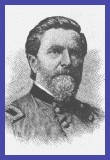The battle was over by noon, with nearly 700 of Morgan's men captured, fifty-seven killed and sixty-three wounded. Among the prisoners were Colonel Duke and Colonel Morgan. Among the Union casualties was Major Daniel McCook, the sixty-five year old patriarch of the "Fighting McCooks," a popular tag for him and his eight sons, all but one of whom became commissioned officers in the Union army, including one major-general, two brigadier-generals and a colonel. McCook was seeking revenge for the death of one of his sons, General Robert McCook, at the hands of one of Morgan's men in Tennessee in August 1862. The old man was killed in the first firefight, in the early morning fog. The man he was looking for, Captain Frank Gurley, was later tried and acquitted of murder by a Federal military commission and exchanged to Confederate lines. |
On the 17th the 45th rode through Jaspur, Piketown, Beavertown and Jacksonville, where they found the railroad depot a smoking ruin -- yet another reminder of Morgan's passing. They camped there that night and, at three in the morning, headed off again in pursuit. That day they passed Manchester, Vinton, Winchester, Rutland and Chester, the last town only ten miles from Buffington Island. Meanwhile Judah's forces were heading up the river road, through Minersville, Syracuse, Racine and then cross country to Portland, just opposite Buffington Island, a 1.2 mile-long, oval-shaped island close to the Ohio shore. Unfortunately for Morgan, recent heavy rains had made the current fast and dangerous. Also, the river was now deep enough for the Union gunboats that were steaming eastward to cut off his retreat. |
On the night of the 18th Morgan camped near the Portland shore, having vetoed a proposal from one of his subordinates to abandon his 200 wounded to the Federals and swim across with the rest. On the morning of the 19th the trap finally closed on Morgan and his men. Ranged against the Confederates were more than 6,000 Union troops, with Judah heading north along the river and, Hobson hurrying southeast to Portland on the Chester road. Meanwhile the Federal gunboat Moose moved into position at the southern tip of Buffington Island, while other gunboats steamed toward the battle site. Outnumbered nearly four to one, the Confederates were forced to fight with their backs to the river, in a small valley covered with lush corn fields. The battle began in the early morning fog, when a Confederate force was sent to attack an earthworks that local militia had built to guard the ford. Finding the earthworks abandoned, Morgan ordered the 5th Kentucky Cavalry under Colonel Smith to picket the road to Pomeroy, a river town south of Buffington Island. But when the fog suddenly lifted, Smith's skirmish line discovered a detachment of General Judah's men, only 100 yards to their right. Smith's men opened fire with 100 carbines and charged the Federals, driving them back in a panic. The Confederates wounded six of the enemy and took fifty prisoners, but their success was temporary. |
Hearing the gunfire, the Moose headed up the chute to the northern tip the island, firing at Confederates on the bank. Meanwhile Judah's line, with the 5th Indiana Cavalry at its center, moved against Smith's regiment, outflanking it with its superior numbers. Soon after, Colonel Kautz, with an advance detachment of 200 men from Hobson's force, charged into the valley from the west. Other of Hobson's units were close behind them on the Chester Road. A newspaper correspondent on the scene, Whitelaw Reid, wrote that "As Hobson's guidon fluttered out in the little valley by the river bank, every member of that little rebel band that had defiled a hundred thousand knew the contest was over." Shortly after 9:00 a.m., the Federals charged, with the 3rd Ohio and 8th Michigan regiments in the lead, and broke the Confederate line in a cornfield The battle soon turned into a chaotic rout, with trapped Confederates struggling desperately to escape the valley as the Moose and a Federal battery on a nearby hilltop shelled their positions. |
With Duke guarding his rear, Morgan led a column of nearly 1,000 men down a steep ravine toward the river, then made his escape north along the river bank, which Hobson had heard was impassable. Morgan's younger brother, Colonel Richard Morgan, was not so lucky, however. Retreating down the road to Basham, he and his men were intercepted at Basham Church by troops under General Shackleford. After an hour's fighting, with the 45th held in reserve, Shackleford's troops charged, driving the Confederates from their position in a dense woods and an adjacent field. |
General James Shackelford |
